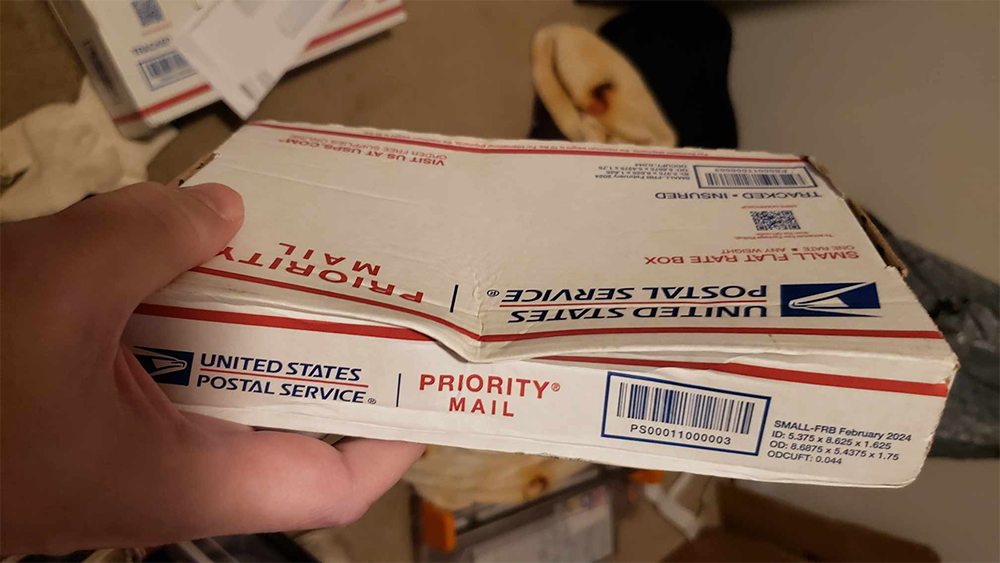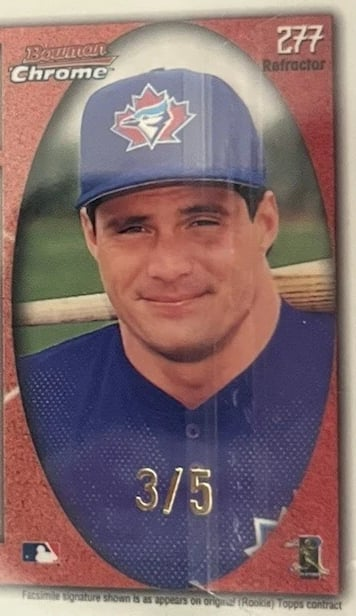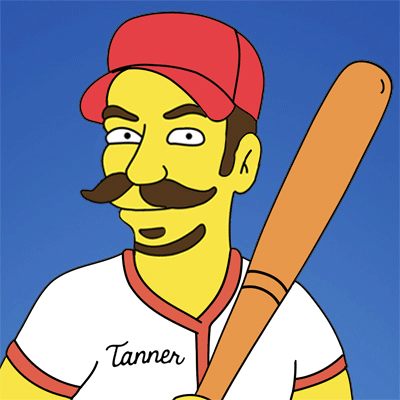I know you’ve felt this before, too.
You secure a big card for your collection, and you wait. and wait. and wait. You check the tracking more times than you care to admit. If the card seems stuck somewhere in transit, and there is finally movement again, it feels like a small victory. But then you wonder … if/when the card does come in, what if there is a problem with it?
All of that describes me perfectly this past week. When the package finally arrived all the way from Tokyo via the original owner’s grandson who pulled this from a pack decades ago, here is what it looked like …

Gahhh – noooo! I hope the seller put it in a hard case! And I hope whatever happened to the package didn’t cause the case to bend or crack!
Thankfully, the card was safe and sound. (PHEW!) So, what exactly is this card I’m making such a big deal about, anyway?
1998 Bowman Chrome Golden Anniversary Refractor Jose Canseco #/5

There are grails and there are GRAILS. In today’s collecting world, a low serial number is seen as common. Back in the 90s? Not so much. If you collect 90s cards, you likely know that several cards serial numbered between 25 and 50 can fetch thousands of dollars for stars.
Red Crusade, Mirror Gold, Totally Certified Platinum, PMG, Brilliants 24kt are just a few of the most sought after cards for collectors. Unicorns, grails, and white whales are the preferred nomenclature for such gems as these. While these are voraciously hunted for by set collectors, player collectors, and flippers alike, they are numbered between /24-/50.
Collectors steeped into the flashy cards of today may find it unusual that such “high” serial numbers can command such big premiums, often outshining 1/1s at the auction block.
Why is this?
Not to take anything away from superfractors and barrel cards, but 90s cards are a perfect snapshot during the playing days of many of our heroes. While barrel cards and superfractors will continue to be made each year (I hope so – I LOVE them!) they can’t make another PMG card of your favorite guy during his playing career. If you are an old timer, you may be currently in the middle of a several decade long hunt for some of these.
Ahh, the thought of opening a pack of cards and pulling one of these gems of your favorite player while watching him on television…how can you beat that?
While I have most of the playing career grails of Jose Canseco, the 1998 Bowman Chrome Golden Anniversary Refractor has always eluded me. 1/1s notwithstanding, it is his rarest serial numbered card created during his playing career. Limited to just five copies, it is wild to think that there are five times more Crusade Reds out there, and ten times more 98 PMGs! It is one of the very few playing career cards of Jose’s that I just figured would more than likely be unobtainable.
While I’m a big fan of the crazy graphics and foils used in many 90s cards, Bowman stayed true to a more subdued timeless design that it is known for – a lineage that spans beyond the half century the Bowman Chrome Anniversary Gold Refractor purports to commemorate – a heritage untouchable by any of the other grails.
Bowman History Lesson
In 1927, Jacob Warren Bowman founded Gum, Inc. – a company that would go on to create various trading card sets, with its first baseball offering being 1939 Play Ball. In 1941, Gum, Inc. halted the production of Play Ball baseball cards, due to World War II causing severe production shortages of key card production material. Gum production shifted largely to military rations instead of trading cards.
In 1948, the card set emerged rebranded as Bowman. 1955 was the last vintage Bowman year, as Topps bought Bowman in 1956, and brought the brand back to life in 1989. less than a decade later, Bowman commemorated its storied history with the Golden Anniversary parallels – the paper parallel received a /99, the chrome /50, and finally, the chrome refractor /5.
I don’t remember a time when I was this excited / anxious for a card to finally land in my mailbox. If you miss out on a Mirror Gold, it can leave a sting that will stay with you, but at least you know there is a chance the opportunity to pick one up again will arise, even if it may take another decade or more. With these, there is a legitimate chance another may never be seen again.
The fact that this card is from 1998 carries extra meaning for me, as well. It was the year I graduated high school, so it was in some sense, a card that was created before I became an adult. While I was in the middle of my hiatus from the hobby at the time, I’d still check the box scores in the newspaper to follow Jose’s 1998 season – a season where he hit more home runs than any other in his career…and without the use of performance enhancing drugs! (Per a 2012 Sportsnet interview.)
=============
Oh, and this card has a touch of a conspiracy theory attached to it as well. If you flip the card around, this is the picture …

Is this Jose, or his twin Ozzie? I asked AI, and it initially said it thinks it is Ozzie with an airbrushed hat, then said Jose, then went back to saying Ozzie. What say you? This is a tough one for me to decide, but I’d love to know the truth!
===========
To capitalize on nostalgia, card companies have reimagined some of the hallowed card sets from the 90s, but none have come close to capturing us collectors like the genuine article. Meanwhile, Bowman’s pedigree remains stronger than ever, producing some of the hobby’s most sought after and priciest rookie cards, with various parallels sometimes fetching millions of dollars, surpassing pretty much any other type of baseball card on the market.
It amazes me that the same company that created a Ted Williams rookie in 1939, stopped production due to World War II, also created some of the most valuable Mike Trout and Shohei Ohtani cards, but most importantly (to me at least!) one of the most valuable Jose Canseco cards ever produced: the 1998 Bowman Chrome Golden Anniversary Refractor /5.




Leave A Comment
You must be logged in to post a comment.